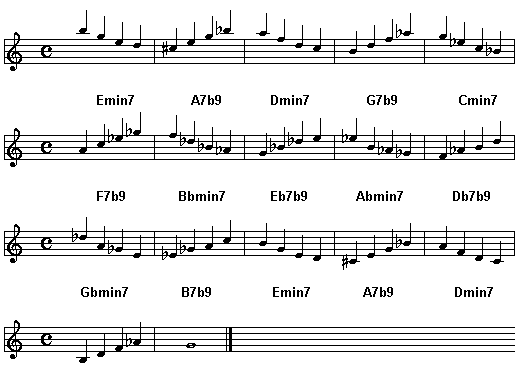Theory 3 – II-7 | V7 | IThis is where we get to the fun stuff! This chart should give you the knowledge it took me two or three years to finally acquire. This is how major scales apply to the three main types of chords you will have to deal with as an improviser. This is one reason to get your scales together so you can play them all so they sound the same. Up, down, backwards, forwards, sideways, and in your sleep! This chart is in the key of C. It’s up to you to transpose it to all the other keys. Also, see the page on pentatonic and blues scales and how they are used, here. | |
| Chord Type | Scale Type |
| C Major, CMajor7(9,11,13) | C Major Scale from C to C |
| C minor,Cminor7(9,11,13) | Bflat Major Scale from C to C |
| C Dominant7(9,11,13) | F Major Scale from C to C |
The scales are all from C to C because you must always respect the chord that is sounding at the time. In other words, if you are playing on a C Major chord, then home base, or tonic, is C. | |
This is a very basic chord/scale chart, but I hope to impress upon you that scales are very important. They are at the root of improvisation. My old teacher, Danny Patiris said to me once, “If you can’t play a major scale, then what can you play?” He was right.
Let’s get right to the heart of the matter, shall we? If you take the most common chord progression in the world, the II-7 – V7 – I, and analyze it, you come away with an understanding that will make things a little more clear. First, a little explanation of chords. A chord is two or more notes (usually at least three) played simultaneously, or as an arpeggio, which is a chord, played one note at a time. Using only the notes in the major scale of the key you are in, if you stack up four notes in thirds on top of each scale step, you will get the 7th chords found in that key. See example below. This will give you some very important information that will be the same in all major keys. See Theory 4 for more information about chords.
This is a II-7 V7 I in the key of C:
The II-7 chord is a minor chord. In the key of C, that would be a Dmin7 chord. D – F – A – C. That chord takes a C major scale from D to D. This is the Dorian mode.
The V7 chord is a dominant chord. In the key of C, that would be a G7 chord. G – B – D – F. That chord takes the C major scale from G to G. This is the mixolydian mode.
The I chord would be a major chord. In the key of C, that would be a C Major 7 chord. C – E – G – B. That chord takes the C major scale from C to C.
So, as you can see, these three chords take the same scale, the only thing that changes is the chord that is sounding. You must always play on the chord that is being played. You would be well advised to practice this progression in all keys. This, again, is a very brief explanation of harmony. These are the basics that all improvisers should know. Here is a cool bebop pattern over II-7 V7 progressions.
| |
Search saxlessons.com
If you found this site helpful, please donate.










